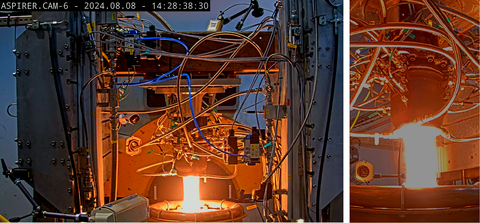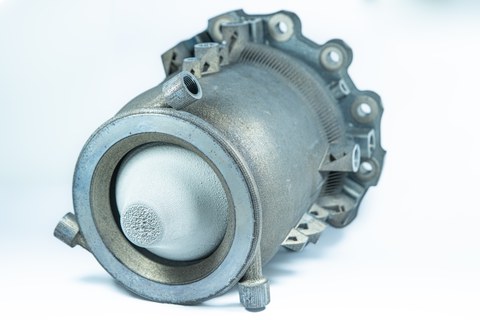Nov 19, 2024
3D printing meets space travel: First successful test of an additively manufactured hydrogen peroxide/kerosene aerospike engine
The "Space Transportation Systems" working group at the Chair of Space Systems at TU Dresden has achieved a breakthrough in space technology. As part of the ASPIRER project funded by the European Space Agency (ESA), the scientists successfully carried out the world's first hot gas test of a 3D-printed aerospike engine with a more sustainable fuel combination of highly concentrated hydrogen peroxide and kerosene. The project is being implemented in cooperation with the Fraunhofer Institute for Material and Beam Technology IWS, ArianeGroup and the Warsaw Institute of Aviation.
Compared to conventional rocket engines with bell nozzles, aerospike engines save a significant amount of fuel and score highly in terms of efficiency. However, they are also more complex and more difficult to control.
During the test campaign, the engine ran both in monopropellant mode with only one propellant and in bi-propellant mode with both propellants. In monopropellant mode, the hydrogen peroxide is decomposed by an integrated chemical catalyst at high temperatures. Only water vapor and oxygen remain as end products, making the fuel a more environmentally friendly alternative to conventional fuels. In bi-propellant mode, kerosene is also injected, whereby the mixture ignites itself without additional mechanical components. The engine is designed for an operating pressure of 20 bar and delivers 6 kN thrust at full load.
The main challenge with aerospike engines lies in cooling. It is only through the use of additive manufacturing in the form of modern 3D printing processes such as laser powder bed fusion (LPBF) that these engines can be sensibly designed and manufactured. The scientists also successfully tested a newly developed, heat-resistant ceramic coating for the combustion chamber elements.
Thanks to their lightweight and compact design, aerospike engines are suitable for various mission scenarios, such as launch vehicles, expeditions to Mars and Saturn's moon Titan or lunar landers. In the latter application scenario in particular, aerospike engines could represent a more sustainable alternative to conventional, hydrazine-based engines, the use of which is viewed critically due to health and environmental risks. The special shape of the engines also allows greater design freedom, so that lunar modules can be built flatter. This simplifies loading and unloading by astronauts and the deployment of rovers.
The Institute of Aerospace Engineering is also investigating the suitability of alternative methods for engine control and their advantages over conventional systems. In the long term, the aim is to overcome the low level of technological maturity and the associated uncertainties of aerospike engines.
Contact
Dr. Christian Bach
Chair of Space Systems
Institute of Aerospace Engineering
Phone: 0351 463-38722
E-Mail:
Web: Space Transportation Systems - Chair of Space Systems - TU Dresden


